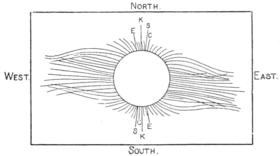tem, being, of course, strongest near the sun. The belief is gradually growing among scientists that the earth, the sun, and the planets are all magnetic bodies, and have these bonds of connection between them-in addition to the Newtonian gravitation. This is a most fascinating field of research, and, though full of difficulties, yet attracts the attention of many who are convinced that one of the most pressing duties of the hour is to clear up the problems connected with the transmission of energy from the sun to the earth in other forms than the ordinary or sunlight radiation. It is entirely probable that the secular variations of the weather changes from year to year, and even from month to month, are bound up with these solar forces, and that the solution of these questions will carry with them much information of practical use to civilized man.
The coronas of the past forty years are shown on Chart III, taken from the report of the eclipse of 1896 (August 9th), by A. Hansky. It arranges the coronas in the eleven-year period so far as the dates at which the eclipses occurred permit this to be done, and by comparing them in vertical lines the similarity is at once seen for the respective quarters of phases of the period. The forecast there given for 1900 is seen to resemble 1867, 1878, and 1889, but it differs in orientation from that on Chart IV, which was prepared by the author. The four coronas on the left in Chart III are taken at the sun-spot maximum, and the appearance is that of total confusion in the structure of the rays;  Chart IV.—Bigelow’s Forecast of the Corona of May 28, 1900. E, earth’s axis; K, axis of ecliptic; S, axis of sun; C, C. poles of the solar corona. the second and the fourth columns are for the sun's medium intensity at about halfway between the maximum and the minimum, and they show a system of polar rays taking on structural form, the second column being at a stage of diminishing and the fourth at one of increasing solar activity; the third column gives the corona when the spots are at a minimum of frequency and the sun is in a comparatively quiescent state, wherein the polar rifts are very distinct and the equatorial wings or extensions greatly developed.
Chart IV.—Bigelow’s Forecast of the Corona of May 28, 1900. E, earth’s axis; K, axis of ecliptic; S, axis of sun; C, C. poles of the solar corona. the second and the fourth columns are for the sun's medium intensity at about halfway between the maximum and the minimum, and they show a system of polar rays taking on structural form, the second column being at a stage of diminishing and the fourth at one of increasing solar activity; the third column gives the corona when the spots are at a minimum of frequency and the sun is in a comparatively quiescent state, wherein the polar rifts are very distinct and the equatorial wings or extensions greatly developed.
The successful observation of a solar corona depends upon three conditions: the selection of the instrument, its proper mounting, and the photographic process, regarding each of which a few sug-
